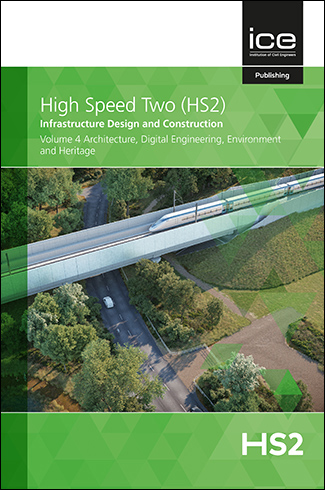High Speed Two (HS2): Infrastructure Design and Construction - Volume 4 Architecture, Digital Engineering, Environment and Heritage
The main construction of HS2, Britain’s new zero carbon, high-speed railway, began in September 2020, when delivery activity on Phase One moved from enabling works, scheme design and preparatory work to full construction of the railway. The new railway will link London and the West Midlands and eventually extend services to the North and Scotland. High-speed trains powered by zero carbon electricity will reach speeds of 225mph and transform journey times, while opening up capacity on the existing, conventional railway network.
This volume of High Speed Two: Infrastructure Design and Construction from the HS2 Project, contains a collection of papers submitted to HS2 Ltd’s Technical Papers Competition. Contributions have come from consultants, contractors, suppliers and third-party stakeholders involved in the delivery of HS2. As part of HS2’s Learning Legacy programme, the organisation seeks to share its learnings and best practices with the rest of the industry throughout the project lifecycle. This volume includes high-quality papers on best practice in planning, design, construction and management for large-scale railway infrastructure projects. It is divided into three sections: design and architecture, digital engineering and environmental heritage.
For more papers from HS2 Ltd’s Technical Papers Competition, please see volumes 1, 2 and 3 of this series.
High Speed Two (HS2): Infrastructure Design and Construction - Volume 1
High Speed Two (HS2): Infrastructure Design and Construction - Volume 2
High Speed Two (HS2): Infrastructure Design and Construction - Volume 3 Design and Engineering
Foreword
Introduction
The HS2 programme
Part 1: Design and architecture
Designing with landscape maintenance in mind, T Stroud, C Brintrup and S Fancourt
Colne Valley Western slopes: maximising habitat creation within a large infrastructure project, M Hobbs, S Railton, I Crowhurst, C Cantle, J Cullis and C Chantler
Resilient river landscapes – River Cole realignment: mitigating climate change through landscape design, M Beswick
The cutting edge (a resilient plant procurement strategy supporting HS2’s Green Corridor), S Fancourt and C Brintrup
Technical process improvement through a systems based approach, A Hill and H Woodcock
Railway drainage design in constrained environments A case study in the vicinity of HS2 Birmingham Interchange Station, J Cobley and J Baron
Rethinking means of escape design for disabled people at HS2 stations using a bespoke rapid modelling tool, R Buschinelli De Goes, C Fox, D Ettehadieh and N Smith
Part 2: Digital engineering
Driving efficiency and sustainability in material reuse through GeoBIM, J Neville, N Pye, P Fair, C Brook, I Mouhtar and S Boden
Streamlining design coordination: connecting High Speed Two to the West Coast Mainline, J Turner, B Mazalu-Dragu, B Todhunter, K Taverner, R Winthrop and N Mendham
Landmark and passenger experience study, C Brintrup, S Woodward-Moor and D Edge
Environmental surveys management – digital innovation, S Nikel, A Egleton, D Mccloud and E Ashford
Part 3: Environment and heritage
Reducing emissions in construction: non-road mobile machinery retrofit, A Davidson, N Wait, R Cairns, I Trinder, D Fawcett, D Marsh, C Desouza, J Thorpe, N Welch and D Green
Clean Air Gas Engine (CAGE): reducing emissions by replacing diesel power in construction, A Davidson, N Wait, C Desouza, D Marsh, D Green, P Andrews and S Chapman
St Mary’s Church: demonstrating the limitless possibilities and value of on-site archaeological public engagement in construction projects, R Wood and I Hawker-Yates
Alternative fuels and additives in construction, A Davidson, N Wait, l Trinder, D Fawcett, D Marsh, D Green and C Desouza
Investigating differences between life cycle assessment tools on major infrastructure schemes, E Percy, R Hafizi and A Berry


No customer reviews